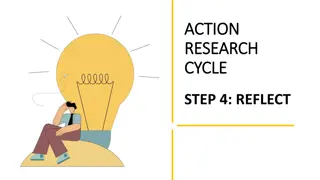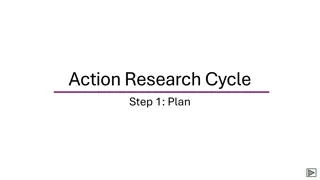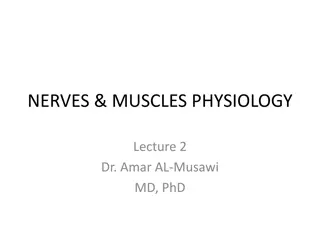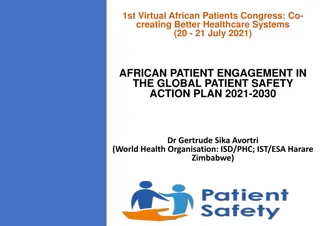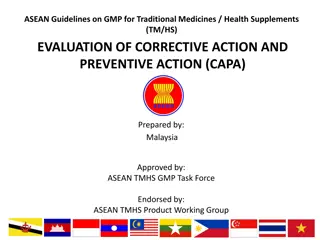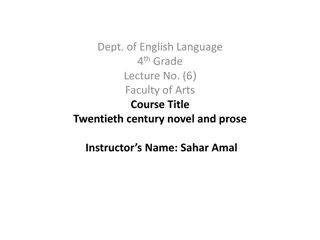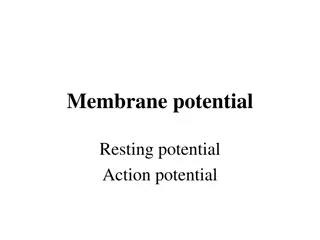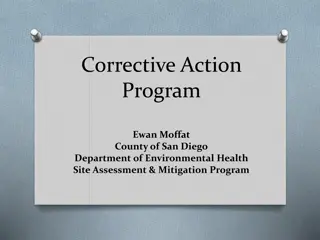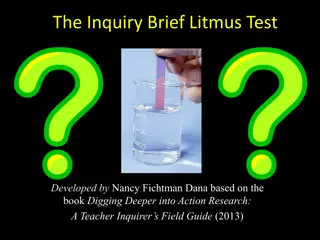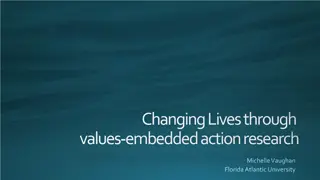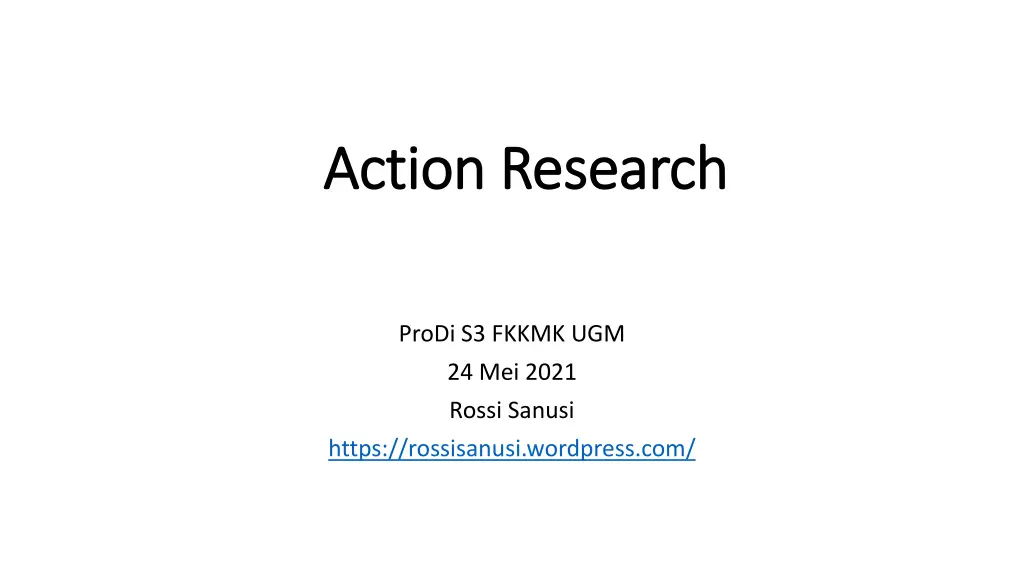
Understanding Design Science in Action Research and Reflection
Explore the intersection of design science, action research, and reflection in various professional contexts. Learn how these methodologies aim to improve practice and address practical challenges through the creation of artifacts. Discover insights from research studies and systematic reviews on evaluating action research and the concept of reflection.
Uploaded on | 0 Views
Download Presentation

Please find below an Image/Link to download the presentation.
The content on the website is provided AS IS for your information and personal use only. It may not be sold, licensed, or shared on other websites without obtaining consent from the author. If you encounter any issues during the download, it is possible that the publisher has removed the file from their server.
You are allowed to download the files provided on this website for personal or commercial use, subject to the condition that they are used lawfully. All files are the property of their respective owners.
The content on the website is provided AS IS for your information and personal use only. It may not be sold, licensed, or shared on other websites without obtaining consent from the author.
E N D
Presentation Transcript
Action Research Action Research ProDi S3 FKKMK UGM 24 Mei 2021 Rossi Sanusi https://rossisanusi.wordpress.com/
AR = ? Meyer, J. (2000). Evaluating action research. Age and ageing, 29(suppl_2), 8-10. Cordeiro, L., & Soares, C. B. (2018). Action research in the healthcare field: a scoping review. JBI database of systematic reviews and implementation reports, 16(4), 1003-1047.
Sumber: https://www.pinterest.co.uk/pin/288934132335098118/ Observe = Evaluating Reflect = Specifying Learning
Marshall, T. (2019). The concept of reflection: a systematic review and thematic synthesis across professional contexts. Reflective Practice, 20(3), 396-415. Sintesis konsep Reflection lihat Tabel 3. Definisi Reflection:
Positioning design science Natural Science Social Science Design Science Empirical science - aims at describing and explaining the actual world in the present (as- is) or the past (has been) Design science - aims at improve and change the world in the future (to- be) - by developing and introducing artefacts in practice Sumber: Erik Perjons. (2019). Introduction to Design Science PPt diunduh 22 Mei 2021
Design scienceis the scientific study and creation of artefacts as they are developed and used by people with the goal of solving practical problems of general interest An artefactis an object made by humans with the intention to be used to address a practical problem in a practice Artefacts: Sistem, prototype, metoda, model, guidelines, requirements, algoritma dst.
Design science needs to develop artefacts that are: generic (solutions for generic problems) new, novel, original based on the knowledge base/scientific body of knowledge contributing to the knowledge base/scientific body of knowledge well described, so it is possible to critically discuss and evalute the artefact using rigouros scientific strategies and methods evaluated/tested communicated to both researchers and practitioners
DS vs DSR Design science research creates solutions to specific classes of relevant problems by using a rigorous design process Design science investigates the design science research process and creates standards for its rigour. (Winter, 2008)
Sein et al (2011) They introduce Action Design Research, inspired by action research They argue that design science research methods have focused too much on building an artefact and have relegated evaluation to a separate phase. In order to address this shortcoming, they propose action design research as an alternative method of design science research, in which building, organisational intervention, and evaluation are intertwined
AR Sebagai Intervensi Bennett, E. (1994). Is Clinical Audit Action Research? Educational Action Research, 2(3), 415-421. Montgomery, A., Doulougeri, K., & Panagopoulou, E. (2015). Implementing action research in hospital settings: a systematic review. Journal of health organization and management. Cook, W. K. (2008). Integrating research and action: a systematic review of community-based participatory research to address health disparities in environmental and occupational health in the USA. Journal of Epidemiology & Community Health, 62(8), 668-676.
Menyusun Kriteria Audit Mengum- pulkan Data Audit Klinik Kriteria dipenuhi? Ya Tidak Perkecualian dipenuhi? Tidak (=deviasi) Ya Data Epid SR Dx & Rx SiKon Pasien SiKon NaKes SiKon RS Beralasan? Pelayanan Klinik Ya Tidak (=defisiensi ) Analisis Akar Peneybab Koreksi!
Tahap Audit Klinik 1. 2. 3. 4. Membuat alat ukur. Mengumpulkan data. Menganalisis data. Menyimpulkan hasil audit.
1. Membuat Alat Ukur (Panitia Audit) a. Menetapkan spesifikasi audit: Judul (Dx, Rx, Ex, Lx) Tujuan (Standar dipenuhi?) Sumber Data (Inklusi & Eksklusi) Identifikasi Pasien (Umur & Jenis Kelamin) Cakupan (pasien & pemberi pelayanan) dan jangka waktu audit Identifikasi Audit (Pertama/Ulang; Medis/ Keperawatan/Gabungan)
b. Menyusun Pedoman Audit: Alasan Dx, Rx, Ex, Lx Prosedur: * SOP (Prospektif & Saat-sama)/ * Hasil (Retrospektif): - Status keluar RS - LoS - Kematian Komplikasi & Critical Mgt
2. Mengumpulkan Data (Asisten Audit) a. Mengamati (Saat-sama), Menelaah RK/RM (Prospektif/Retrospektif) Mengisi Form b.
3. Menganalisis Data (Panitia Audit) a. Mengidentifikasi Deviasi & Defisiensi: Deviasi = tidak memenuhi kriteria (bukti pasti bhw pelayanan medis/keperawatan akan/sedang/telah diberikan seoptimal mungkin). Defisiensi = Deviasi yg tidak beralasan (Alasan = bukti yg kurang pasti). b. Mengidentifikasi Akar-Penyebab (Root-cause Analysis)
4. Menyimpulkan Hasil Audit (Panitia Audit) Mengusulkan tindakan koreksi dan tindak-lanjut Meringkas & Membuat laporan
Kesimpulan AR upaya kesehatan (UKP dan UKM)? ADR = AR yg menghasilkan Artifact. Bentuk artifact? Clinical Audit AR, DR atau ADR? AR rancangan penelitian atau intervensi? AR layak untuk disertasi?

